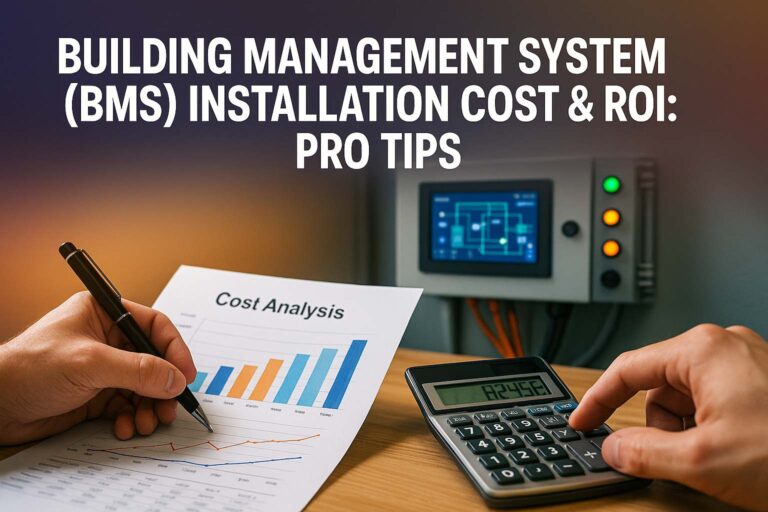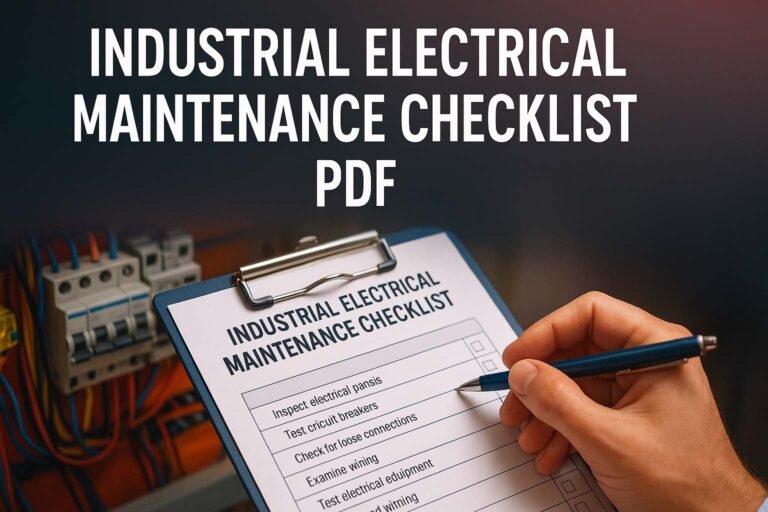Energy Audit for Commercial Buildings: Step-by-Step Guide
Energy consumption is one of the biggest operational expenses for any commercial building. Whether it’s an office complex, a retail center, or a hospital, energy bills can quickly eat into profit margins if not managed properly. That’s where the concept of Energy Audit for Commercial Buildings comes in—a structured process that helps property managers and building owners identify where energy is being wasted and how to improve efficiency.
Table of Contents
Table of Contents

An energy audit is not just about reducing costs. It’s also a practical way to contribute to sustainability, reduce greenhouse gas emissions, and comply with local energy efficiency regulations. More importantly, it provides a clear path to upgrading systems like HVAC, lighting, and insulation with quantifiable benefits.
Most building owners and facility managers understand the need for energy efficiency but don’t know where to start. A comprehensive Energy Audit for Commercial Buildings provides that starting point. This guide will walk you through each step of the process, from planning to implementation.
Key Takeaways:
- An energy audit identifies inefficiencies in a building’s energy use.
- It helps reduce operational costs, carbon footprint, and energy waste.
- Audits include data collection, site inspections, analysis, and actionable recommendations.
Why Energy Audit for Commercial Buildings is Important
Commercial buildings account for a significant portion of total electricity consumption worldwide. With rising energy prices and environmental concerns, businesses are under pressure to reduce their energy footprint. Energy audits help uncover hidden problems in systems such as lighting, air conditioning, motors, water heating, and insulation.
Beyond saving money, audits can also extend the life of equipment, improve indoor comfort, and support corporate sustainability goals. For example, older lighting systems or poorly maintained HVAC units can lead to both higher costs and lower employee productivity due to discomfort.
Energy audits also help in preparing buildings for green certifications like LEED or BREEAM. In many cities, local laws even mandate energy assessments for buildings over a certain size.
Know more about Top Electrical Engineering Software: AutoCAD, ETAP, MATLAB Reviewed
Step-by-Step Process of Energy Audit for Commercial Buildings
Conducting an energy audit is a multi-phase process. It involves both data analysis and hands-on inspections. Below is a detailed breakdown of each step.
1. Pre-Audit Planning and Goal Setting
Before you start collecting any data, it’s important to set clear goals. These could be:
- Reducing energy bills by 20%
- Meeting a specific energy-use intensity (EUI)
- Qualifying for tax incentives or certifications
At this stage, the building owner or manager should choose a certified energy auditor or firm. The audit scope—whether it’s just lighting or a whole-building review—must be finalized.
2. Data Collection and Historical Analysis
The auditor gathers past utility bills—electricity, gas, water—for at least 12 to 24 months. This helps understand:
- Seasonal trends
- Peak demand periods
- Baseline energy consumption
The auditor also reviews architectural plans, equipment lists, and occupancy schedules. The objective is to understand how the building functions on a daily, weekly, and seasonal basis.
3. On-Site Inspection and Equipment Survey
This step involves a physical walk-through of the building. Key systems inspected include:
- HVAC systems
- Lighting and control systems
- Insulation and glazing
- Motors and drives
- Water heating and plumbing
Thermal imaging cameras, lux meters, airflow sensors, and data loggers are often used to collect precise performance data. Auditors may also talk to staff to understand how the building is used in real life, which often differs from the design intent.
Know more about Building Management System (BMS) Installation Cost & ROI: Pro Tips
4. Data Analysis and Benchmarking
After collecting field data, auditors analyze it using energy modeling software. The data is compared against benchmarks like:
| Benchmarking Tool | Description |
|---|---|
| ENERGY STAR Portfolio Manager | Compares building performance to similar buildings nationwide |
| ASHRAE Level Audits | Industry-standard audits with increasing depth (Level 1 to 3) |
| Energy Use Intensity (EUI) | Measures energy per square foot/year |
This step helps quantify how far your building is from the ideal performance and which systems are contributing most to inefficiency.
5. Identification of Energy Conservation Measures (ECMs)
The core output of an audit is the list of ECMs—actionable items that can save energy. Each ECM includes:
- Description of the improvement (e.g., switch to LED)
- Cost estimate
- Estimated annual savings
- Payback period
- Return on investment (ROI)
For example:
| ECM | Investment | Annual Savings | Payback Period |
|---|---|---|---|
| Replace T8 fluorescent with LED | $15,000 | $5,000 | 3 years |
| Install VFD on HVAC fans | $10,000 | $3,500 | 2.85 years |
| Insulation upgrade | $8,000 | $2,000 | 4 years |
Know more about How to Start an Electrical Contracting Business: Best Guide
6. Cost-Benefit Analysis and Prioritization
Since budgets are limited, not all ECMs can be implemented at once. Auditors provide a ranked list based on:
- Simple Payback
- Internal Rate of Return (IRR)
- Net Present Value (NPV)
- Environmental impact
This allows decision-makers to choose low-cost, high-impact improvements first and plan others for future phases.
7. Reporting and Recommendations
All findings are documented in a detailed energy audit report. A good report includes:
- Executive summary
- Utility data analysis
- Equipment inventory
- ECMs with financial metrics
- Maintenance suggestions
- Next steps
This report becomes the foundation for energy management strategies, funding applications, or certification submissions.
8. Implementation and Monitoring
After accepting the recommendations, the building management starts implementing the selected ECMs. Project management and coordination with vendors are crucial here. Post-implementation, it’s essential to monitor the results. Data loggers, smart meters, and building management systems help verify that projected savings are being achieved.
Types of Energy Audit for Commercial Buildings
There are three main levels of audits based on ASHRAE guidelines:
| Audit Level | Description | Depth |
|---|---|---|
| Level 1 – Walkthrough Audit | Basic data analysis and site visit | Low |
| Level 2 – Standard Audit | More detailed energy analysis and ECMs | Medium |
| Level 3 – Investment-Grade Audit | Highly detailed analysis for capital investment decisions | High |
Most commercial buildings benefit from a Level 2 audit, which provides a solid balance of cost, depth, and actionable insights.
Know more about Top Electrical Equipment Suppliers in UAE and UK
Common Findings in Commercial Building Audits
- Over-ventilation during unoccupied hours
- Poor insulation in ductwork and roofing
- Lighting left on in unused areas
- Simultaneous heating and cooling
- Old chillers running at low efficiency
Fixing these issues can save 10–40% of the total energy cost depending on building age and system quality.
Energy Audit for Commercial Buildings and ROI Potential
A well-conducted energy audit can produce strong returns. Payback periods are usually between 1 and 5 years. In addition, some local governments and utilities offer:
- Rebates on equipment upgrades
- Tax deductions (like Section 179D in the US)
- Carbon credits
Plus, increased efficiency often leads to better building valuation and tenant satisfaction—intangible benefits that add long-term value.
Role of Technology in Energy Audits
Modern audits leverage software and smart tools to deliver more accurate and quicker results:
- IoT sensors monitor real-time energy use
- AI-based energy modeling tools simulate energy savings
- Cloud dashboards track ECM performance over time
These tools reduce manual errors and allow for ongoing optimization rather than a one-time fix.
How Often Should You Perform an Energy Audit?
While there’s no one-size-fits-all rule, most experts recommend a full energy audit every 3–5 years. However, if you’ve recently expanded, renovated, or seen unusual spikes in energy use, an audit should be conducted sooner.
Conclusion: Why Energy Audit for Commercial Buildings Should Be Your Next Move
In today’s energy-conscious business environment, not auditing your building is like ignoring a leaking tap—it adds up quickly. A well-executed Energy Audit for Commercial Buildings offers you a clear map to reduce costs, increase operational efficiency, and meet environmental goals. From HVAC to lighting, every system has savings potential waiting to be unlocked.
Follow Us on Social:
Subscribe our Newsletter on Electrical Insights for latest updates from Electrical Engineering Hub
#EnergyAudit, #CommercialBuildings, #EnergyEfficiency, #BuildingAudit, #Sustainability, #EnergyManagement, #EnergySavingTips, #GreenBuildings, #HVACEfficiency, #FacilityManagement, #AuditChecklist, #ReduceEnergyCosts, #SmartBuildings, #EnergyAuditGuide, #EcoFriendlyBusiness






